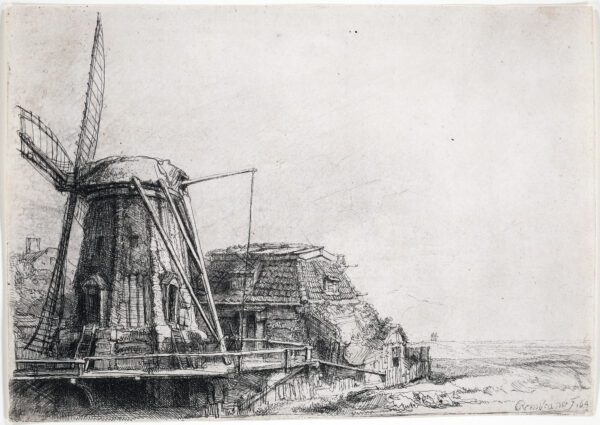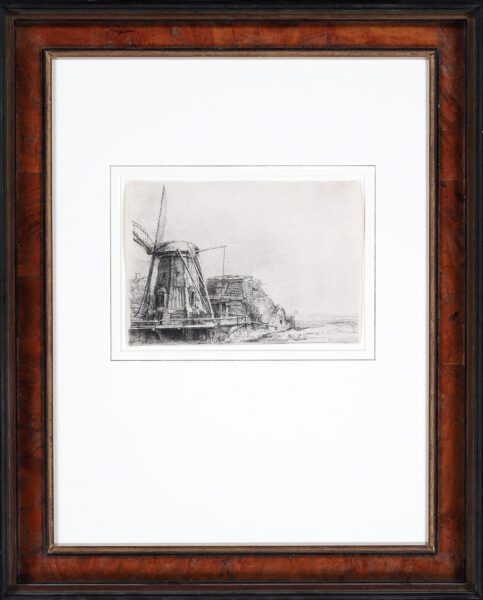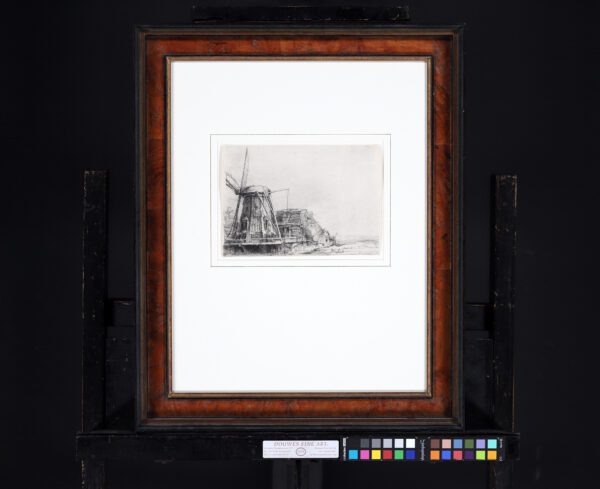“The Windmill”, 1641
etching with touches of drypoint: 14,6 x 20,8 cm;
Trimmed on or just outside the platemark.
Signed and dated lower right: Rembrandt f 1641
"*" indicates required fields
Notes
During his lifetime, Rembrandt’s extraordinary skills as a printmaker were the main source of his international fame. Unlike his oil paintings, prints travelled light and were relatively cheap. For this reason, they soon became very popular with collectors not only within but also beyond the borders of the Netherlands.
The present sheet is an outstanding example of this very famous etching of a quintessentially Netherlandish building and landscape. Without much evidence at all and probably out of romantic sentiment, the windmill depicted here was long thought to be Rembrandt’s birthplace at Katwijk; he was indeed the son of a miller. In 1915, however, Frits Lugt identified the building as the ‘Little Stink Mill’ on De Passeerder bulwark outside of Amsterdam, owned by the Leathermakers Guild – the use of cod liver oil in the treatment of tanned leather explains the stench and its nickname.
The precise description of the construction, the mechanics of the mill and the details of the nearby cottage suggest that Rembrandt may have etched the plate en plein-air. The main body of the structure, cap, sails and platform are rendered with great accuracy, as are the anecdotal elements, such as the tiny figure of the miller about to climb the stairs into the mill with a sack on his back and the woman, possibly washing clothes, in front of the house. To achieve this level of precision, the artist may have used an etching needle thinner than usual. The buildings and the landscape is certainly rendered with an abundance of detail not found in his later ‘economically etched landscapes’ (M. Royalton-Kisch in: Hinterding, 2000, p. 187-88).
Yet the artist’s attention is not limited to the intricate description of the buildings . Rembrandt took great interest in the atmospheric qualities of the scenery: the wide empty flatlands to the right, put into perspective by the two tiny figures standing on the bulwark; the deep, dark shadows under the platform of the mill; and the cloudy, windswept sky indicated by the irregular striations and tonal areas, presumably created by sulphur tint being brushed directly onto the plate, causing a superficial and localised corrosion of the plate. As characteristic of early impressions, the craquelure above the cottage is slightly pronounced – an accidental effect of fine cracks in the etching ground – which, although hardly descriptive of any meteorological phenomenon, adds substance and ambiance to the sky.
The crazing in the centre of the image is due to damage to the etching ground itself, while the slight grey haze in the sky is probably the result of the direct application of the two-dimensionally applied sulphur tint, a precursor to aquatint.
Literature
Bartsch 233; Hind 179;
The New Hollstein Dutch 200, First and only state.
With Nowell-Usticke R: A popular plate. Plate not in existence
Provenance
- Dr Ernst Hauswedell, Buch- und Kunstauktionen, Hamburg, 4./5. December 1953, lot 1368;
- Private collection, Germany.
- Private collection, The Netherlands





